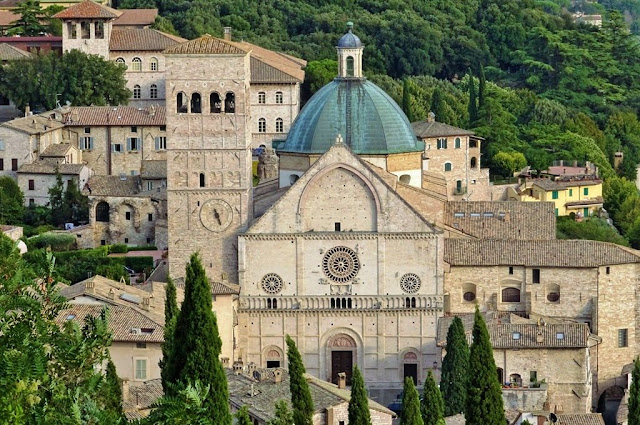Cathedral of St Rufino
Contrary to what is thought, the main patron of the diocese of Assisi is not St. Francis but St. Rufino, revered as the first bishop of the city, the cathedral has been dedicated to him since the first half of the 11th century.
A ´passion´ written in the ninth century says that Rufino bishop of the city of Amasia del Ponto (the current Amasya, in Turkey), after having converted to the proconsul, would have arrived with his son Cesidio to the Marsi region in Abruzzo .
In this area he would have consecrated a church left in custody of his son, while he continued to preach the Gospel to Assisi; but here after a short time he was discovered by the proconsul Aspasio, who later subjected him to many tortures, sentenced him to death for being a Christian, Rufino was thrown into the waters of a river with a stone tied around his neck. An ancient tradition indicates as a place of martyrdom: Costano in the diocese of Assisi, now part of the City Hall of Bastia Umbra, located on the banks of the Chiascio River. A parchment in the archives of the cathedral, remember that already in 1038 in Costano there was a church dedicated to Saint Rufino Martyr.
His body was transported from Costano to Assisi, right where the cathedral erected to the faith of the town of Assisi and the work of Giovanni de Gubbio now emerges, but this is the third built on the tomb of the martyr bishop, it is from the twelfth century ; the first one was built in 412 according to an inscription stored in the left nave and as written in a 1007 document stored in the archive.
Saint Peter Damiani in a famous sermon of his in honor of Saint Rufino, cites a second cathedral built in the eleventh century by Bishop Hugo of Assisi, on the occasion of the transfer of the sarcophagus that contained the bones of the saint, from the place of martyrdom; of this second church there is still the crypt under the current cathedral, with the sarcophagus of the time.
The date of celebration, since the 11th century, is August 11, although mistakes by later copyists moved the party to July 30 at the Roman Martyrology.
The iconography of the holy bishop and martyr is very vast, especially in the city of Assisi; His images are found in all the churches of the diocese, also in the Franciscans. The oldest is the sculpture placed in the arch over the portal of the cathedral, made in the twelfth century.





Comments
Post a Comment